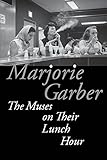The Muses on Their Lunch Hour / Marjorie Garber.
Material type: TextPublisher: New York, NY : Fordham University Press, [2016]Copyright date: ©2017Description: 1 online resource (216 p.)Content type:
TextPublisher: New York, NY : Fordham University Press, [2016]Copyright date: ©2017Description: 1 online resource (216 p.)Content type: - 9780823273720
- 9780823273751
- 814/.54 23
- online - DeGruyter
- Issued also in print.
| Item type | Current library | Call number | URL | Status | Notes | Barcode | |
|---|---|---|---|---|---|---|---|
 eBook
eBook
|
Biblioteca "Angelicum" Pont. Univ. S.Tommaso d'Aquino Nuvola online | online - DeGruyter (Browse shelf(Opens below)) | Online access | Not for loan (Accesso limitato) | Accesso per gli utenti autorizzati / Access for authorized users | (dgr)9780823273751 |
Frontmatter -- Contents -- Acknowledgments -- Preface: The Muses on Their Lunch Hour -- 1. Asking Literary Questions -- 2. Ovid, Now and Then -- 3. Over the Influence -- 4. Fig Leaves -- 5. Baggage Screening -- 6. Identity Theft -- 7. Czech Mates: When Shakespeare Met Kafka -- 8. Occupy Shakespeare -- 9. Shakespeare 451 -- Notes -- Index
restricted access online access with authorization star
http://purl.org/coar/access_right/c_16ec
As a break from their ordained labors, what might the Muses today do on their lunch hour? This collection of witty, shrewd, and imaginative essays addresses interdisciplinary topics that range widely from Shakespeare, to psychoanalysis, to the practice of higher education today. With the ease born of deep knowledge, Marjorie Garber moves from comical journalistic quirks ("Fig Leaves") to the curious return of myth and ritual in the theories of evolutionary psychologists ("Ovid, Now and Then").Two themes emerge consistently in Garber's latest exploration of symptoms of culture. The first is that to predict the "next big thing" in literary studies we should look back at ideas and practices set aside by a previous generation of critics. In the past several decades we have seen the reemergence of-for example-textual editing, biography, character criticism, aesthetics, and philology as "hot" new areas for critical intervention. The second theme expands on this observation, making the case for "cultural forgetting" as the way the arts and humanities renew themselves, both within fields and across them. Although she is never represented in traditional paintings or poetry, a missing Muse-we can call her Amnesia-turns out to be a key figure for the creation of theory and criticism in the arts.
Issued also in print.
Mode of access: Internet via World Wide Web.
In English.
Description based on online resource; title from PDF title page (publisher's Web site, viewed 02. Mrz 2022)


